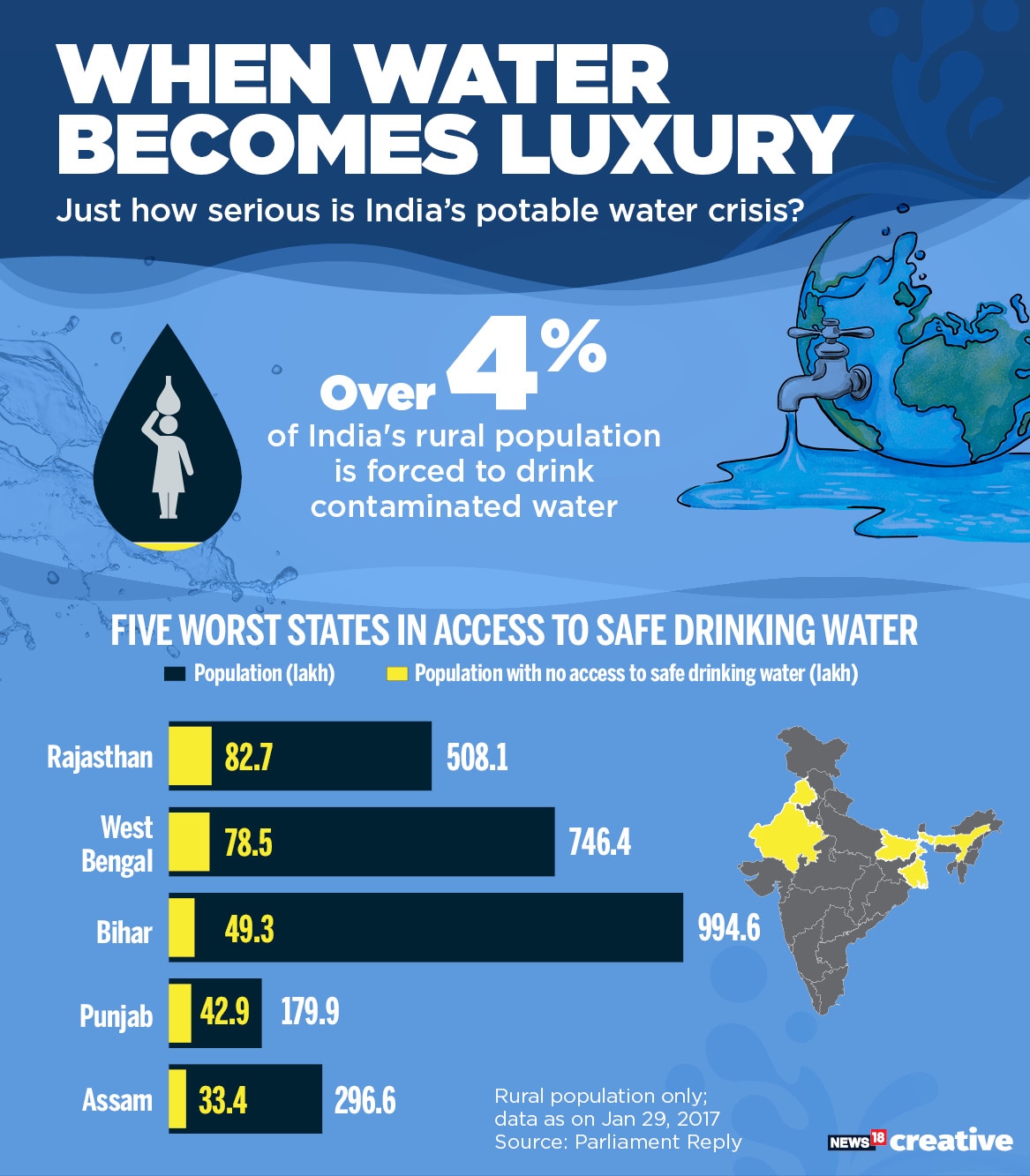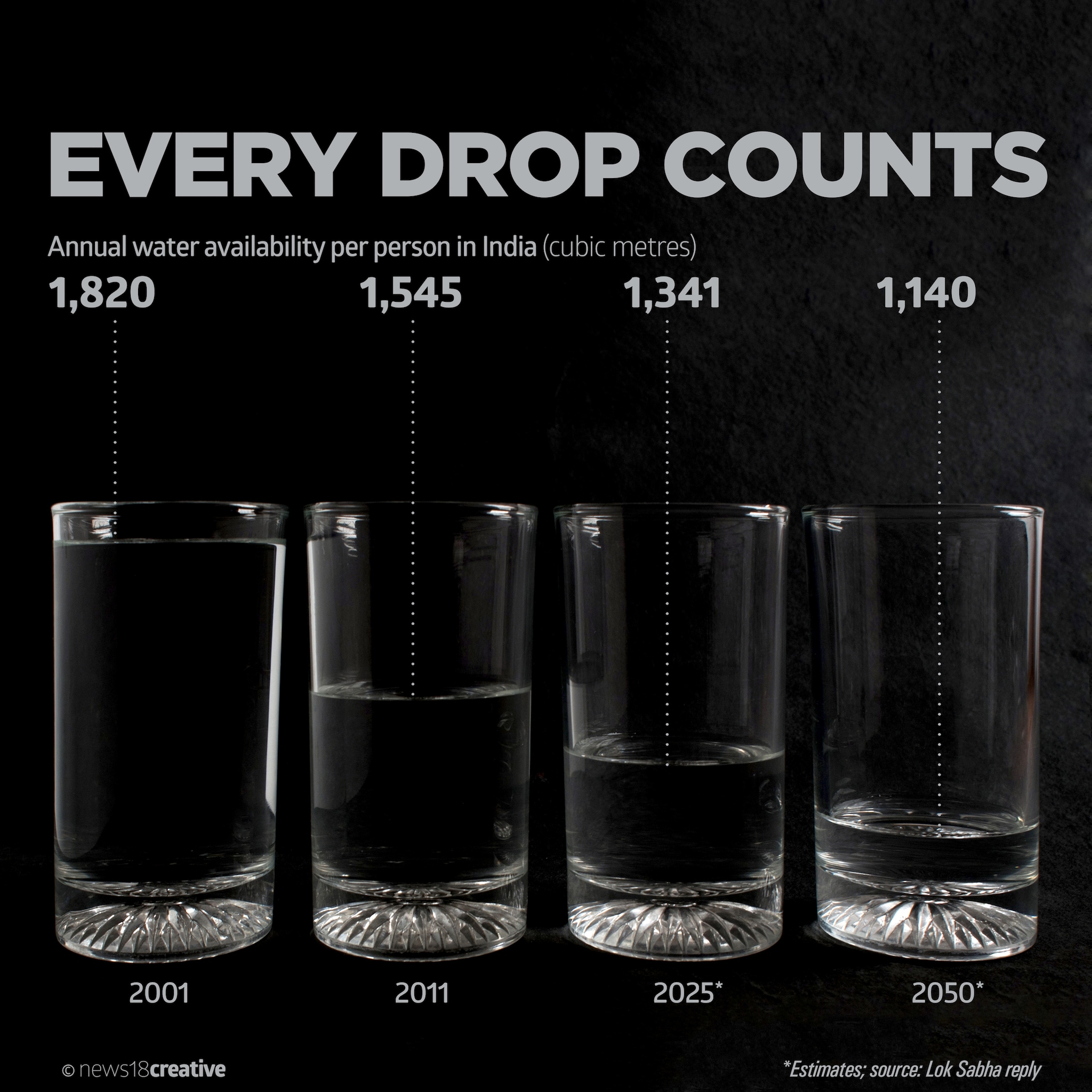It’s not yet March-end, but water woes are already un-ravelling in many parts of India.
Bengaluru, by all accounts, sits on acute water shortages akin to the ones witnessed by Cape Town. According to a statement issued by the Centre for Science and Environment (CSE) ahead of World Water Day, water table there shrunk from 10-12 metres to 76-91 metres in two decades, while the number of extraction wells went up from 5,000 to 0.45 million in 30 years.
In Vidarbha’s farm-suicide-torn Yavatmal, the government medical college has sent home its outstation students, following impending water scarcity. Much of western Vidarbha faces water shortages.
A three-hour drive from there, in coal city Chandrapur, the administration has told the super thermal power project managers to be judicious through the summer in their freshwater usage, as citizens stare at massive water shortages. It’s a city that lives off a small river, now turned into small puddles.
While three units of the 3340-MW power station are likely to be shut down soon, citizens would get water once in two or three days starting from the first week of April. Chandrapur is not the only city to be facing cuts. Across the country, growing number of cities will soon cut water supplies.
Nagpur, the orange city, is witnessing unprecedented water scarcity and lopsided distribution. Yet the city’s water utility, a private company called the Orange City Water Distribution Company Limited, gets a national award for being the most progressive water utility in India. The joke is on Nagpurians.
In drought-prone Marathwada, poignant stories abound of rural women spending hours in search for water.
Coastal Andhra is reeling under water scarcity. In parts of south-western Madhya Pradesh, Chhattisgarh, Gujarat, Odisha and north India, next three months seem to throw a gigantic water crisis.
The Cauvery Delta region in Tamil Nadu is facing extreme water stress. The Godavari — the Ganges of the South — is sans water. The Krishna too, in many stretches, is but a stream of dry pebbles.
Tens of thousands of people from the arid Bundelkhand region are already boarding trains to migrate to the cities, or wherever they could, and escape both, hunger and water scarcity.
What is more, the usually ebullient Narmada that horizontally dissects the country has fallen silent in Bharuch, thanks to a mindless political decision that prompted authorities to quietly empty upstream dams into the Sardar Sarovar Project at a time when the rains were below normal.
Hundreds of sub-rivers across India have fallen permanently silent. The masses along their beds are up and marching towards the cities in steady streams, rocked by sagging agriculture and water scarcity.

Much to worry
On the World Water Day 2018, there is much to worry about. India sits on a freshwater time bomb that promises to alter her demographic and economic character, as many studies warn us.
While drought and water scarcity could be topical and usually grip several regions during the summers, our water crisis is turning more structural and stems from mostly the man-made factors.
It’s also the reason why water conflicts between urban and rural masses, regions and states, districts and blocks, and sectors — from industrial to agriculture to domestic and commercial — are getting fiercer.
Add to that, the climatic aberrations, changing rainfall patterns, alarmingly overexploited ground-water, and we have a perfect recipe for disaster.
Yet, water, and related crises don’t draw the political and economic attention they must, year after every year. Look at how our political-administrative regime has quietly pushed under the carpet, for a silent burial, a crucial July 2016 report on the reforms of water management institutions: it called for a comprehensive restructuring of India’s Central Ground Water Board and Central Water Commission in order to create a new 21st Century management authority equipped to tackle the impending crises.
We continue to flounder with the management of rivers and under-stress aquifers. In Maharashtra, the machines and not humans are a focus of a much-trumpeted programme called Jal-Yukta Shivar, where a rush to clear bills for the deployment of earthmoving vehicles outweighs the wise calls for holistic water management approach, including a re-look at our aquifers, cropping patterns, distributaries and demand.
We have a situation where some parts of India are about to see a biting water scarcity and in the same landscapes, bumper yields of water-guzzling sugarcane with record production of sugar.
India’s water crisis
As the 2016 report submitted by the committee on restructuring the CWC and CGWB observed: “While big dams played a big role in creating a huge irrigation potential, today the challenge is to effectively utilise this potential, as the water that lies stored in our dams is not reaching the farmers for whom it is meant. At the same time, groundwater, which truly powered the Green Revolution, faces a crisis of sustainability.”
“Water levels and water quality have both fallen creating a new kind of crisis, where the solution to a problem has become part of the problem itself. The new challenge is to manage our aquifers sustainably so that we make sure we do not kill the goose that lays the golden eggs,” it said.
This and many other ground reports indicate what we call drought is actually a full blown water crisis, accentuated by our poor planning, as a recent Water Resources Institute (WRI) report indicated.

It said “water shortages are hurting India’s ability to produce power” and that “40 percent of the country’s thermal power plants are located in areas facing high water stress, a problem since these plants use water for cooling.”
“Scarce water is already hampering electricity generation in these regions — 14 of India’s 20 largest thermal utilities experienced at least one shutdown due to water shortages between 2013 and 2016, costing the companies $1.4 billion. It’s an issue that’s only poised to worsen unless the country takes action — 70 percent of India’s thermal power plants will face high water stress by 2030 thanks to climate change and increased demands from other sectors.”
We are putting our water-guzzling industries in water-stressed areas. What do we expect then?
The 2016 report on the CWC-CWGB restructuring says, if the current pattern continues, about half of India’s water demand will be unmet by 2030. Our water tables are falling in most parts; there is fluoride, arsenic, mercury, even uranium in our groundwater. Climate change poses fresh challenges as more extreme rates of precipitation and evapo-transpiration exacerbate impacts of floods and droughts. Our cities produce nearly 40,000 million litres of sewage every day and barely 20 percent of it gets treated; only 2% of our urban areas have both sewerage systems and sewage treatment plants.
The observations underscore that ticking time bomb.
Water stress is driving people to migrate out of their native places. I saw and reported this during the 2016-17 water crisis that hit the once-prosperous Cauvery Delta in Tamil Nadu; or in 2015 and 2016 in Marathwada, in Maharashtra, when the state government deployed a water-train from Miraj to supply drinking water to the citizens of Latur, daily.
In a discussion paper released last month by the FAO titled ‘Water stress and human migration: a global, georeferenced review of empirical research’, its authors from the Oregon State University note that the “linkages between water stress and migration are understudied in India, Central Asia, the Middle East, and the Central Sahel.”
The body of work reviewed by the authors finds a strong consensus among researchers that increased water stress can cause people to decide to migrate.
Come April, and some of India’s poorest would take that decision — driven by water stress, in distress.
(The author is a Nagpur-based journalist and a volunteer for the People’s Archive of Rural India. Views are personal)
*Original article online at https://www.news18.com/news/opinion/opinion-the-ticking-time-bomb-indias-water-crisis-about-to-blow-up-in-our-face-1696839.html
